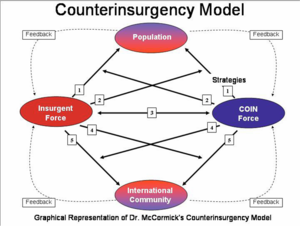This post is prompted by an excellent post by the guys at On Violence. You should read Capturing Australia! COIN is Boring Pt.3Â to which this was my belated comment.

My apologies for coming late to this one, I’ve been on leave for a couple of weeks now and being spending time with the family.
I’ve been interested in designing a counter insurgency game since the mid 1990s. The original trigger for my interest were the decolonisation conflicts of the British Empire. This wasn’t a board game, nor a computer game. The group I belong to designs face to face games for multiple participants, a bit like the sort of command post exercises those of us who’ve done some military or civil contingencies time would recognise.
I never ran the decolonisation game that prompted this, it needed 20 players, which was too many for the free venues and too few to make it economic in the hired halls. However there were a number of spin-off games, including a look at the Palestine/Israel insurgency in 1945-48; Malaya in the 1950s and Aden in the early 60s.
By the time I’d looked at those traditional insurgencies we got into the Iraq and Afghanistan wars. My most recent attempt, which sort of almost counts as a board game (it has a map, which is really only for flavour) looked at the experience from the point of view of the Afghan farmers, and the drivers that took them to insurgency (or not as the case happens). I ran it twice, both times with someone who served in Afghanistan as one of the players.
I come at all this as a hobbyist. I make the games I’d like to play but cannot find commercially. The same is true of the people that I play with, we form a community of game design activists. (Chestnut Lodge Wargames Group, mainly in the UK). Over the years I’ve played games as both an insurgent and a counter-insurgent. They hold a lot of game play and interest. However a lot of it defies easy mechanisms that you can write down on a few pages than just about anyone can understand.
Part of this is that insurgencies aren’t all the same. What works in dealing with one group might only make things work with another. You need to get inside the culture and methods of the insurgents to defeat them. Or at least that is how I read it. Sometimes it will be unpalatable for modern players to play those games, either because of a close connection with someone hurt by the insurgency, or because current moral standards differ from those of the period or culture concerned.
That said, I think it is possible to write good games about insurgency. They just need to be specifically tailored to the insurgency in question and the players appropriately briefed in advance. You also need players that will roleplay it a little rather than just play to mechanisms.
– See more at: http://onviolence.com/?e=739













